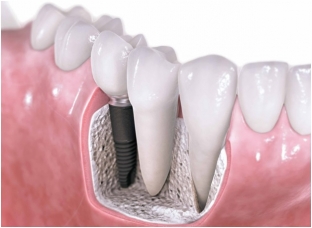The inflammatory process of the coronal or root pulp may be accompanied by necrosis of its tissues. This process is called gangrenous pulpitis and is a late stage of chronic pulpitis, which is accompanied by putrefactive decay of the pulp. In dental practice, gangrenous pulpitis is the second most common form of primary chronic pulpitis, as well as the cause of tooth extraction with the subsequent need for dental implants. More often this form of pulpitis develops after fibrous. Gangrenous pulpitis can develop both in the open cavity of the tooth and in the closed one. The lower molars are affected more often, which is associated with the highest incidence of caries in these teeth.
Main causes of gangrenous pulpitis
Gangrenous pulpitis develops when anaerobic microflora penetrates into the pulp chamber.
The pulp can become infected when the cavity of the tooth is opened during caries treatment.
Deep periodontal pockets, periodontitis of adjacent teeth and trauma to the tooth can also cause the development of gangrenous pulpitis. This type of pulpitis can be the outcome of acute pulpitis or be a primary chronic process. What determines the mechanism of development of gangrenous pulpitis, knows estet-portal.com. The mechanism of development of gangrenous pulpitis depends on the virulence of the microbial flora, the body's resistance, the duration of pulp irritation, the condition of the periodontium and the intensity of caries. It is very important not to lose sight of the condition of the periodontium, since the successful implantation of teeth depends on it in the future, if the outcome of gangrenous pulpitis ends with tooth extraction.

Chronic gangrenous pulpitis is characterized by the following manifestations:
• necrosis of the root and coronal part of the pulp;
• a demarcation shaft is formed in the root pulp at a certain level, which is formed by granulation tissue;
• below this shaft, inflammation of the pulp of a fibrous nature with thrombosis of small veins, necrosis of small arteries and sclerosis is detected;
• above the level of the demarcation shaft, ulceration and necrotization are determined on the pulp.
Symptoms and appearance of the tooth with gangrenous pulpitis
Gangrenous pulpitis in an open cavity is not accompanied by pain. The patient may feel heaviness and discomfort in the affected tooth, biting on the tooth may be accompanied by minor pain. Hot food or drink causes aching pain that does not disappear even after the cessation of high temperatures.
If gangrenous pulpitis has developed in a closed cavity, it is accompanied by pain, as the outflow of exudate is difficult. When the pulp decays from the mouth, a very unpleasant putrefactive odor appears. A tooth affected by gangrenous pulpitis looks “lifeless” outwardly. With pulpitis, regional lymph nodes are enlarged and painful on palpation.
Methods of diagnosis and treatment of gangrenous pulpitis
At the dentist's appointment, the patient often tells that in the past this tooth was very painful, after which the pains disappeared on their own.
On examination, the destruction of the crown of the tooth, discoloration is determined, a deep carious cavity with softened dentin is revealed. Deep probing may cause pain. Percussion and palpation slightly sensitive.
It is advisable to conduct thermodiagnostics to determine the characteristic change in the reaction to temperature in gangrenous pulpitis. When the tooth is exposed to high temperature, the tooth begins to hurt sharply, after the stimulus stops, the pain slowly fades away. Electroodontodiagnostics with gangrenous pulpitis makes it possible to detect a decrease in the excitability of the pulp to 60-90 μA. Radiography allows to detect changes in the periapical tissues.
Conservative methods of treatment of such pulpitis are not used. Treatment of gangrenous pulpitis requires the removal of necrotic pulp. If effective extraction is not possible, extraction is performed and subsequent dental implantation is recommended for the patient.







Add a comment